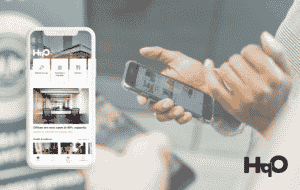
Tenant experience apps such as Boston-based HqO’s can help landlords manage building capacity with an eye toward COVID-safe operations. Image courtesy of HqO
The onset of the COVID-19 pandemic has accelerated the already-existing trends of office technology and hybrid work models for commercial real estate, both of which impact how people interact with buildings around the world.
However, this digital revolution does not necessarily pose a threat to people’s engagement with physical office buildings. In fact, according to the latest market analytics, over 80 percent of top performers still miss their offices even after having worked remotely for nearly a full year.
This sentiment – alongside the fact that 92 percent of CRE owners plan to maintain or increase their tenant experience technology investments in the next year – indicates that the industry can leverage new office technologies to strengthen and recreate communities for both the physical and digital workplaces, as well as to facilitate a safe return to office.
To boost building occupancy and break current remote work habits, commercial office owners need to provide real-time communication about what’s been done at the building, what is currently being done and what will change. Successful strategies complement emerging technological trends and restore faith in the office through confidence and comfort. Tenant experience software such as the HqOS end-to-end operating system aligns directly with these needs and resolves even the trickiest health and safety challenges. Here’s how.
Return-to-Office Objectives
As CRE continues to adopt a more customer-centric business model, tenant sentiment will play the most valuable role in informing goals and action items for property teams. Thus, every return to office strategy needs to address concerns in the key areas of safety, communication, and engagement:
Put Safety First: With employee health and comfort at the forefront of the industry’s minds, deploying a return to office strategy requires the prioritization of tenant safety. This includes updating office protocols and using meaningful building data to adapt your strategy when needed.
Communicate to Generate Tenant Buy-In: In order to truly help tenants see that their offices are safe and to generate tenant buy-in, CRE leaders need to maintain a direct line of communication. Informing tenants and their employees of necessary changes will also generate real-time feedback, enabling property teams to hear concerns as they arise and to adjust accordingly.
Engage to Reestablish Office Value: Landlords can recreate community and collaboration through office technologies that are tuned into your building and surroundings. A tenant experience platform can achieve everything from promoting local food and retail spots, to creating physical and digital opportunities – such as happy hours and fitness classes – that foster the socialization and engagement that your employees crave.
The Solutions
In order to effectively address these concerns, you’ll need the right technology toolset for your portfolio. Here’s what every property team should look out for:
Safety: Property teams need to find solutions for contact-tracing, managing office capacity, sanitation and space booking needs. This includes everything from a tech-enabled visitor registration and access management tool, to a capacity management system that can field tenant requests to come into the office. These all contribute to reducing congestion in public areas and establishing touchless experiences.

Chase Garbarino
Communication: Property teams also need to communicate safety protocols and important building information to as many tenants as possible. Such functionalities on a property management platform may include a content section for updates, a community forum, support systems, push notifications for time-dependent messaging, and audience segmenting features that can help owners disseminate information in targeted ways.
Engagement: In order to keep your tenants and employees engaged, you will need to bring amenities directly to building occupants, as well as to collect data on how people are using your buildings. Digital programming opportunities — such as networking and professional speaker series, giveaways, virtual volunteering, fitness and wellness classes and trivia — can connect people to one another while also enhancing overall workplace culture, no matter where they work.
Ultimately, commercial office owners need a partner that can move quickly without sacrificing quality for the return to office. To learn more about how tenant experience software can establish solutions that are seamless and fit to your specific needs, request a free demo of HqOS today.
Chase Garbarino is co-founder and CEO of HqO.




 |
| 
